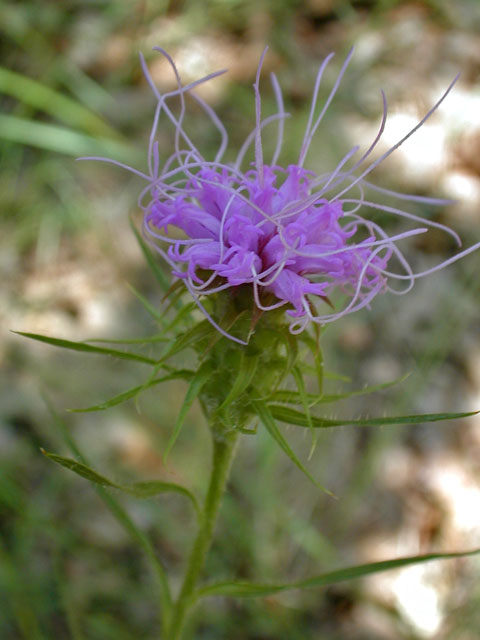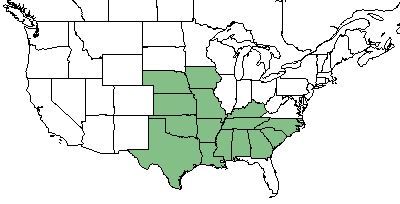Difference between revisions of "Liatris hirsuta"
(→Conservation and Management) |
HaleighJoM (talk | contribs) (→Ecology) |
||
| (9 intermediate revisions by 5 users not shown) | |||
| Line 1: | Line 1: | ||
{{italic title}} | {{italic title}} | ||
| + | Common name: scaly blazing star<ref name= "USDA Plant Database"/> | ||
<!-- Get the taxonomy information from the NRCS Plants database --> | <!-- Get the taxonomy information from the NRCS Plants database --> | ||
{{taxobox | {{taxobox | ||
| Line 18: | Line 19: | ||
}} | }} | ||
==Taxonomic Notes== | ==Taxonomic Notes== | ||
| − | Synonyms: | + | Synonyms: ''Laciniaria squarrosa'' (Linnaeus) Hill; ''Liatris squarrosa'' (Linnaeus) Michaux var. ''hirsuta'' (Rydberg) Gaiser.<ref name="weakley">Weakley, A.S. 2015. Flora of the southern and mid-atlantic states. Working Draft of 21 May 2015. University of North Carolina at Chapel Hill, Chapel Hill, North Carolina.</ref> |
| − | Varieties: none | + | Varieties: none.<ref name="weakley">Weakley, A.S. 2015. Flora of the southern and mid-atlantic states. Working Draft of 21 May 2015. University of North Carolina at Chapel Hill, Chapel Hill, North Carolina.</ref> |
==Description== | ==Description== | ||
<!-- Basic life history facts such as annual/perrenial, monoecious/dioecious, root morphology, seed type, etc. --> | <!-- Basic life history facts such as annual/perrenial, monoecious/dioecious, root morphology, seed type, etc. --> | ||
| − | ''L. hirsuta'' is a perennial forb/herb of the ''Asteraceae'' family native to North America. <ref name= "USDA Plant Database"> USDA Plant Database [https://plants.usda.gov/core/profile?symbol=LISQH https://plants.usda.gov/core/profile?symbol=LISQH] </ref> | + | ''L. hirsuta'' is a perennial forb/herb of the ''Asteraceae'' family native to North America.<ref name= "USDA Plant Database"> USDA Plant Database [https://plants.usda.gov/core/profile?symbol=LISQH https://plants.usda.gov/core/profile?symbol=LISQH] </ref> The erect stems grow up to 1 m tall and have a pubescent texture. The fibers of the old basal leaves are usually absent. The lower leaves are 3.5 dm long, 0.5-1.5 cm wide, and glabrous to pubescent. The rachis is also pubescent, Involucres are usually pedunculate and cylindric, 2-3 cm long, and 1-2 cm in diamter. The bracts are acuminate or acute, squarrose, pubescent to glabrous, with a green to purple color. The heads are 20-30 flowered with peduncles that are absent or 2.5 cm long. The corolla lobes are lavender, 4-7 mm long. The nutlets are 5-7 mm long and pubescent. The pappus is plumose and 12-15 mm long.<ref name="weakley">Weakley, A.S. 2015. Flora of the southern and mid-atlantic states. Working Draft of 21 May 2015. University of North Carolina at Chapel Hill, Chapel Hill, North Carolina.</ref> |
==Distribution== | ==Distribution== | ||
| − | ''L. hirsuta'' is found in | + | ''L. hirsuta'' is found from Iowa and Nebraska to Mississippi, Louisianna, and Texas. There are disjunct populations in northwest Georgia.<ref name="weakley">Weakley, A.S. 2015. Flora of the southern and mid-atlantic states. Working Draft of 21 May 2015. University of North Carolina at Chapel Hill, Chapel Hill, North Carolina.</ref> |
| − | |||
==Ecology== | ==Ecology== | ||
===Habitat=== <!--Natural communities, human disturbed habitats, topography, hydrology, soils, light, fire regime requirements for removal of competition, etc.--> | ===Habitat=== <!--Natural communities, human disturbed habitats, topography, hydrology, soils, light, fire regime requirements for removal of competition, etc.--> | ||
| − | ''L. hirsuta'' is found in glades and prairies. <ref name= "Weakley 2015"> Weakley, A. S. (2015). Flora of the Southern and Mid-Atlantic States. Chapel Hill, NC, University of North Carolina Herbarium. </ref> | + | ''L. hirsuta'' is found in glades and prairies.<ref name= "Weakley 2015"> Weakley, A. S. (2015). Flora of the Southern and Mid-Atlantic States. Chapel Hill, NC, University of North Carolina Herbarium. </ref> Specimens have been collected from sandy loam on roadside, hardwood hammock margins, clearing in longleaf pinewoods, wiregrass longleaf pine woods, longleaf pine savanna, and moist loany sand of pine-oak regions.<ref name = "FSU herbarium"> URL: http://herbarium.bio.fsu.edu. Last accessed: June 2018. Collectors: Loran C. Anderson, R.K. Godfrey, Steven P. Christman, R.Kral. States and counties: Florida (Washinggton, Escambia, Highlands, Santa Rosa) Georgia (Thomas) Alabama (Lowndes)</ref> |
| − | + | ===Phenology=== <!--Timing off flowering, fruiting, seed dispersal, and environmental triggers. Cite PanFlora website if appropriate: http://www.gilnelson.com/PanFlora/ --> | |
| + | This plant flowers June through September.<ref name="weakley">Weakley, A.S. 2015. Flora of the southern and mid-atlantic states. Working Draft of 21 May 2015. University of North Carolina at Chapel Hill, Chapel Hill, North Carolina.</ref> | ||
<!--===Seed dispersal===--> | <!--===Seed dispersal===--> | ||
<!--===Seed bank and germination===--> | <!--===Seed bank and germination===--> | ||
<!--===Fire ecology===--> <!--Fire tolerance, fire dependence, adaptive fire responses--> | <!--===Fire ecology===--> <!--Fire tolerance, fire dependence, adaptive fire responses--> | ||
| − | <!--===Pollination===--> | + | <!--===Pollination===--> |
| − | <!--=== | + | <!--===Herbivory and toxicology===--> |
| − | <!--==Diseases and parasites==--> | + | <!--===Diseases and parasites===--> |
| − | ==Conservation and | + | ==Conservation, cultivation, and restoration== |
| − | ''L | + | ''L. hirsuta'' is listed as endangered by the Maryland Department of Natural Resources Natural Heritage Program, and as probably extirpated by the Michigan Department of Natural Resources Natural Features Inventory.<ref name= "USDA Plant Database"/> |
| − | == | + | ==Cultural use== |
==Photo Gallery== | ==Photo Gallery== | ||
<gallery widths=180px> | <gallery widths=180px> | ||
</gallery> | </gallery> | ||
==References and notes== | ==References and notes== | ||
Latest revision as of 18:09, 14 July 2022
Common name: scaly blazing star[1]
| Liatris hirsuta | |
|---|---|

| |
| Photo by Michael Haddock at Kansas Wildflowers Database | |
| Scientific classification | |
| Kingdom: | Plantae |
| Division: | Magnoliophyta - Flowering plants |
| Class: | Magnoliopsida - Dicots |
| Order: | Asterales |
| Family: | Asteraceae |
| Genus: | Liatris |
| Species: | L. hirsuta |
| Binomial name | |
| Liatris hirsuta L. | |

| |
| Natural range of Liatris hirsuta from USDA NRCS Plants Database. | |
Contents
Taxonomic Notes
Synonyms: Laciniaria squarrosa (Linnaeus) Hill; Liatris squarrosa (Linnaeus) Michaux var. hirsuta (Rydberg) Gaiser.[2]
Varieties: none.[2]
Description
L. hirsuta is a perennial forb/herb of the Asteraceae family native to North America.[1] The erect stems grow up to 1 m tall and have a pubescent texture. The fibers of the old basal leaves are usually absent. The lower leaves are 3.5 dm long, 0.5-1.5 cm wide, and glabrous to pubescent. The rachis is also pubescent, Involucres are usually pedunculate and cylindric, 2-3 cm long, and 1-2 cm in diamter. The bracts are acuminate or acute, squarrose, pubescent to glabrous, with a green to purple color. The heads are 20-30 flowered with peduncles that are absent or 2.5 cm long. The corolla lobes are lavender, 4-7 mm long. The nutlets are 5-7 mm long and pubescent. The pappus is plumose and 12-15 mm long.[2]
Distribution
L. hirsuta is found from Iowa and Nebraska to Mississippi, Louisianna, and Texas. There are disjunct populations in northwest Georgia.[2]
Ecology
Habitat
L. hirsuta is found in glades and prairies.[3] Specimens have been collected from sandy loam on roadside, hardwood hammock margins, clearing in longleaf pinewoods, wiregrass longleaf pine woods, longleaf pine savanna, and moist loany sand of pine-oak regions.[4]
Phenology
This plant flowers June through September.[2]
Conservation, cultivation, and restoration
L. hirsuta is listed as endangered by the Maryland Department of Natural Resources Natural Heritage Program, and as probably extirpated by the Michigan Department of Natural Resources Natural Features Inventory.[1]
Cultural use
Photo Gallery
References and notes
- ↑ 1.0 1.1 1.2 USDA Plant Database https://plants.usda.gov/core/profile?symbol=LISQH
- ↑ 2.0 2.1 2.2 2.3 2.4 Weakley, A.S. 2015. Flora of the southern and mid-atlantic states. Working Draft of 21 May 2015. University of North Carolina at Chapel Hill, Chapel Hill, North Carolina.
- ↑ Weakley, A. S. (2015). Flora of the Southern and Mid-Atlantic States. Chapel Hill, NC, University of North Carolina Herbarium.
- ↑ URL: http://herbarium.bio.fsu.edu. Last accessed: June 2018. Collectors: Loran C. Anderson, R.K. Godfrey, Steven P. Christman, R.Kral. States and counties: Florida (Washinggton, Escambia, Highlands, Santa Rosa) Georgia (Thomas) Alabama (Lowndes)